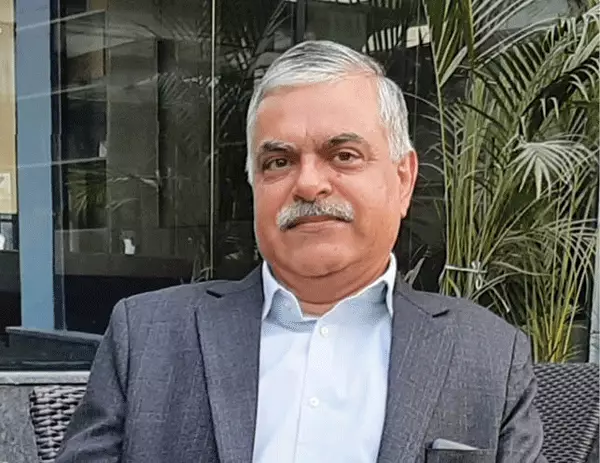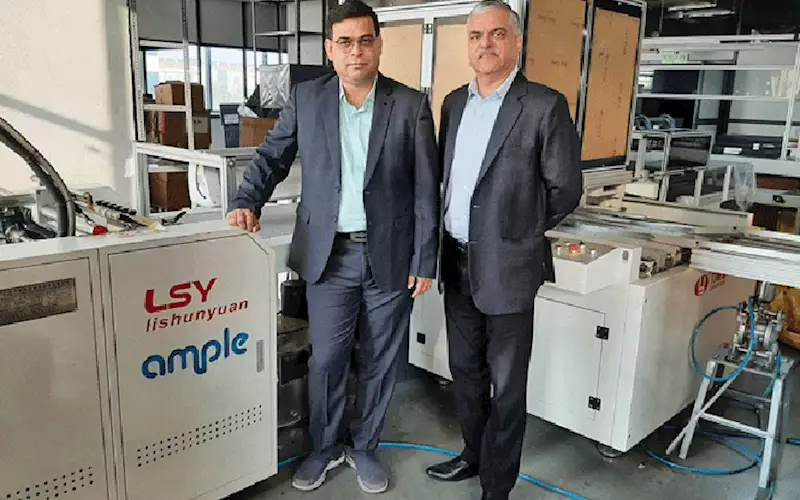Knowledge of application is the key to selling
Sachin Kala of Ample Graphics narrates his journey — from being a sales person to starting Ample Graphics — in an exclusive interview with Rahul Kumar
28 Apr 2021 | By PrintWeek Team & Rahul Kumar
I was born and brought up in Bagru village near Jaipur, Rajasthan. My father had a grocery store in the village and I used to help him in the shop since the age of 10. That’s how I learned calculating fast and quick.
I aimed to establish my own business from day one, but it did not happen due to circumstances. After completing school, I joined Government Polytechnic College for Printing in Ajmer. Later I graduated as a BTech and completed my MBA in marketing from Sikkim Manipal.
In 1993, printing technology was a new subject for students as well as for the institution. Often, we did not have the right faculty with knowledge of the subject, and we had to study independently. It was a new subject, and I thought I could do something new and complete the course.
It was a three-and-a-half-year course. The good thing about the course was industrial training for a duration of four to eight months. I split my training period between a newspaper publishing house and a packaging company.
Into packaging
At the packaging unit, I focused on estimation, costing and production supervision. Later, I joined the same packaging unit in Jaipur on 11 July 1996 and served them for around four years.Later, I worked for another packaging printing company for additional four years.
During that period, I learnt about the limitation of production, the need for optimisation, automation, and practical difficulties, especially during production. At that time, machines were not technically advanced. So, most of the work needed manual intervention. Based on my experiences, I used to suggest which production segment requires automation and how can it be achieved.
In 2004, I joined TechNova Imaging Systems as a salesperson. Initially, I was in the chemical business, and later, I was shifted to the capital equipment segment for its printing plates’ processors. Still later, I shifted from Jaipur to Delhi to the iCTP division of TechNova for the northern part of the country.
In 2009, I joined Coimbatore-based Autoprint Machinery. The company is well known for its small offset printing presses and had recently entered into the post-press segment when I joined them.
It was a new segment not just for me but for Autoprint as well. Particularly, it was a little difficult for me as I had come from a well-established brand. Initially, my responsibility was to handle the northern part of the country. Gradually, I started handling the pan-India business.
I worked with Autoprint for more than four years, and I learnt a lot as we established a new segment.
Starting Ample
Rajeev Jagga, whom I had known since my TechNova days, and I started Ample Graphics in July 2015. We got our first order from Prem Industries. Amazingly, we also received the order for our 500th machine from Prem Industries.
When we started, there were many concerns. The chief among them was finding the right customers. The customers had their own concerns. As we were new in the market, they were worried about their products’ after-sales service, should we not survive and fold the business. It wasn’t easy to convince customers. We were not in a condition to give any certification or any other document except our commitments and dedication. We were very clear from day one that we will carry our customers’ confidence and belief in us. Therefore, we are always grateful to Prem Industries and Nutech Packagings. If they did not give us our first orders, Ample wouldn’t exist today.
Learning from Ample
We started our operation with a single service engineer, and he left us when we sold our first machine during the installation. Today, we have a service team of 10 people. We will be adding a few more soon.
In my more than two decades of work experience, I have realised that a salesperson can change the game if he can speak about applications rather than machine specifications and the equipment’s price. For me, knowledge and implementation of the application is the key.
We have more than 70% repeat orders. Meaning, we have sold more than 500 machines to slightly more than 100 customers. The rest of 30% of orders come from friends and references. That’s why there are no salespersons in our team.
Now, however, we are aggressively focusing on business development and sales. We have a strong presence in the northern and western parts of the country. Now, the focus is on East and South India.
Presently, we are a complete solution provider for corrugation solutions, rigid box solutions, lamination solutions and window-patching solutions. Along with machines, we have started consultancies, from establishing the production plant to sell products in the market.
Selling capital equipment
There is a misconception about Chinese machines in India that those machines are cheap and not worth the investment. But the truth is, China manufactures all kind of machines, especially in terms of price and applications. At the same time, Chinese manufacturers have the mindset that Indian buyers need only cheap machines. The fact is, every business is cost-competitive, and a buyer should consider the ROI of the equipment before buying.
Capital equipment with tough and lengthy ROI doesn’t make sense in the present scenario. A European machine has a longer life than a Chinese machine, but so is the difference in investment and payable interest.
We are planning to add a few more products to our portfolio as per current demand, and for that, we are in touch with Chinese manufacturers. As Ample’s core focus is on finishing products for packaging, these new products will be for packaging.
We are also planning to establish an assembling unit in India, hopefully in Delhi-NCR. It was supposed to be executed last year, but it couldn’t happen due to the pandemic. With this, we will serve our Indian customers faster and more economically because it will save freight and import cost.
Building relations
I believe in relationships, and I don’t find any major changes in customers’ behaviour towards Sachin Kala as an employee or an employer.
If you believe in your work and work accordingly, there will be no problem whether you are an employee or an employer. One day the situation will change, and you will be on the other side of the table.
I travel a lot because of my business, so I spend every single free moment of my life with my family – wife, daughter and son. I visit spiritual places, especially temples, watch cricket and football matches and enjoy vegetarian food.
Rajeev Jagga: Continued focus on service has helped us succeed

Jagga of Ample Graphics narrates how the company managed to capture the Indian market with high-end Chinese products
Born and brought up in Delhi, I graduated in electronics. I worked in software for four years before venturing into business in the IT industry in partnership with college friends in 1992. In those days, it was businesses which used computers and my job was to sell these machines. Since then, I have been selling capital equipment.
In 1998, I started as the distributor (marketing and logistics partner) for TechNova’s digital print media division in Delhi. Soon, the operation expanded to include Rajasthan and later entire North India. The workload made me quit my earlier computer venture.
My exposure in the printing industry started with the support from Standard Machinery, for whom I continued to liaison their capital equipment sales in my area of influence. This continued until Standard Machinery started to move away from printing to food packaging machines. This allowed me to venture into this segment on my own.
Starting Ample
When we started Ample Graphics in 2015, the time was ripe for introducing China to the Indian printing industry with the right combination of services. Many had brought Chinese equipment to India but failed to identify the right product and didn’t provide local service to their customers. The focus was on price (the proverbial Chinese price), which did not fetch the right technology and quality suitable for India’s mid-level packaging companies. These companies were facing competition from their larger counterparts who could afford the European equipment.
Ample Graphics picked up on this aspect. We identified the Chinese companies that exported their wares to European and American markets and introduced them to Indian customers. The initial year was tough. We had to convince customers to buy expensive, high-end Chinese machines from a start-up. But soon, we got an opening from three customers – Prem Industries and NutechPackaging from Noida, and Dev Print & Pack from Ahmedabad.
Focus on service
The focus on service and the right machine selection helped us get these customers’ initial approval of these initial customers, and there was no looking back. Customer testimonies, the emphasis on exhibitions, and continued focus on service have helped us with several repeat and referral orders. By the third year, we had sold our 100th machine.
I am glad that the focus has not waned, and our customers have continued to support us. It is no coincidence that our 500th machine was sold to our very first customer. This feat of 500 machines has been achieved from just 108 customers located all over the country, from Guwahati to Coimbatore.
Impact of the pandemic
The pandemic could be a watershed year for the Indian packaging industry. Many customers are looking for an alternative to shore up their supply chain and reduce dependency on China. This opens up big opportunities. At the same time, Indian customers are moving away from unpackaged foods, increasing the demand for packaging.
Online delivery services have greatly increased the need for packaging. Restaurants, cloud kitchens and many home cooks have designed attractive packaging, thereby raising the standards. Some of the brick-and-mortar stores have also launched their online versions. The ban on plastic has also increased the need for paper packaging. All these factors combined have grown the packaging industry exponentially. The last few years have been tough on the commercial printing companies, and we see many of them migrating to packaging now.
The increased demand and low labour availability have suddenly opened a big market for automation. The market for new, faster, and more technologically improved equipment, which requires less labour, is gaining fast. This is a great opportunity for Ample Graphics.











 See All
See All